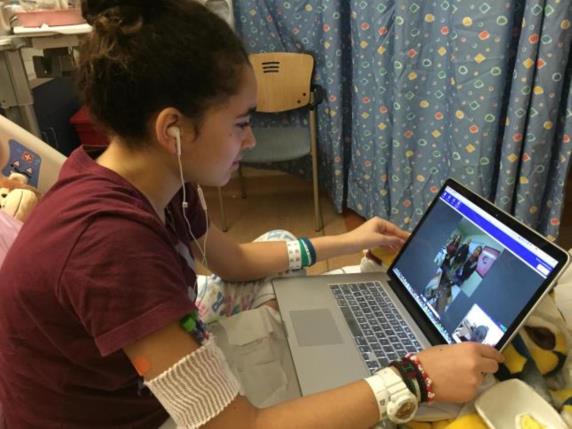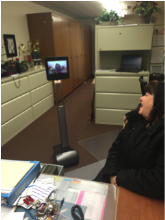Robotic Telepresence Device Allows Student to Attend School Virtually While Receiving Treatment

Naya Salah attends seventh grade from her hospital bed using the teleconferencing device Beam.
Naya Salah kicked off her year at Stratford School’s Santa Clara Middle School as a typical seventh grader. She was a good student, she had a role in the school play, and she was very social.
But everything changed Jan. 20, 2016.
A few days prior, she didn’t feel well at school, and her friend told her her eyes looked yellow. On Jan. 20, doctors gave her the diagnosis — leukemia.
“It was a very sudden diagnosis,” Principal Becky Turner said. “We were all very, very surprised by it, her family probably most of all.”
“I looked up leukemia and got upset,” Salah, 13, said. “We went to the hospital that night. It was my longest stay at the hospital. And the chemo really hit me hard.”
Because the leukemia and chemotherapy would render her immune system depressed, Naya was told that she would have to miss the rest of the school year.
“She didn’t cry about the fact that she’d lose her hair,” said Naya’s mother, Tala Khalaf. “She cried about not being able to go to school for seventh grade.”
Her classmates were shocked. But rather than wallow in the sad news, they decided to do something about it. A friend of hers, Eva Sandman, told her parents about Naya’s condition.
Brad Sandman and Tanya Jenkins both work at Suitable Technologies, based in Palo Alto. The company makes Beam, a mobile videoconferencing device that can be operated remotely with a computer or a phone.
The Sandmans spoke with their company and convinced them to let Naya indefinitely lease the Beam+. Within a couple of weeks, Naya was virtually attending classes through Beam, even socializing with her friends, while she was lying in the hospital or at home in San Carlos, getting treatment or recovering.
“I think it’s pretty cool,” she said. “I feel it’s more high tech. I feel really lucky to be in the Bay Area because of stuff like this.”
“The Beam has been a huge transformation in her life, honestly,” mother Khalaf said. “It’s made a huge, huge difference in her recovery and healing on so many levels — emotional, intellectual, even spiritual. She’s so motivated to wake up and attend school. Virtual attendance in school has made a huge difference.”

The portion of the Beam+ that is physically present at Naya’s school in her place consists of a 10-inch LCD flat-panel screen, attached to a base with motorized wheels that allow it to move around through remote controls issued by the “pilot’s” device — a Windows or OS X device — running the Beam+ app. “It’s like an iPad on a stick,” Naya said.
The device includes two HDR cameras, four microphones and a built-in speaker. It can roll at over 2 miles per hour and can connect to 2.46 GHz or 5 GHz WiFi networks. Naya’s Beam+ has been upgraded with an 8-hour battery, lasting the entire school day. (The standard version has a 2-hour battery.) After a day’s use, the pilot can drive it back to its dock to charge.
Beam works similar to Facetime: The user can see around her, and everyone looking at the screen can see the user. Naya uses her laptop keyboard or smartphone to operate the device at school.
“I can participate in projects with friends in science,” Naya said. “I can help out in groups. It’s nice because I pay attention in class; I can see what’s happening. It helps me participate. “
During the first few weeks she used Beam, other kids crowded around it, looking at it, commenting and interacting with her.
“I was in the hallway – I couldn’t even move,” Naya said. “The first week, or month even, everyone crowded around it.”
“I think there was this feeling of, ‘Oh my gosh, what’s going on?’ for the first couple of days,” Turner said. “But then it was like, ‘Oh, Naya’s here’ when the Beam comes.”
Beam+ costs $1,995, according to the Suitable Technologies website. That includes the videoconferencing device, a dock, a power cable and a USB keyboard.
Salah has been in the news before. She sang “America the Beautiful” in Arabic in a 2014 Coca-Cola TV ad that aired during the Super Bowl and the Sochi Winter Olympics. She was 10 years old and in fifth grade at the time, and she happened to be student body president of Palo Alto’s Stratford Elementary School.
The ad generated some controversy, particularly among critics who said that song should only be sung in English. But Naya had a level-headed response: “America is one union but with a mix of cultures, and it doesn’t matter who you are. We should always be friendly to each other no matter what difference you have.” The controversy died down.
Naya said her leukemia – or cancer of the blood cells – is not present in her system anymore. But she will have to keep taking chemotherapy for the next 2 ½ years.
“She’s a very humble girl,” Turner said. “She could have taken it so many different ways. She’s got such a good head on her shoulders. She believes she’s going to get through this, and hopes that maybe she can use the experience to help others. She’s been very positive.”
Naya agrees. “This technology can definitely be used in hospitals and for children who can’t go to school. In science, we were learning about cancer right when I got it. I am proud that I can continue to learn about all this. I’ve learned so much from this experience.”